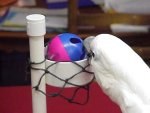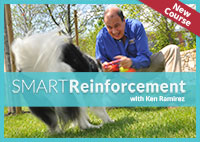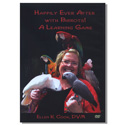How do the bird owners you work with respond to the idea of training their birds? What happens to the bird/person relationship once they experience clicker training and the responsiveness and capability it displays in their birds?
Visit our bird clicker training pages for additional articles, ideas, and helpful links including the bird clicker list.
Read and use: Getting Started: Clickertraining for Birds, by Melinda Johnson. Available as a Book and as a Kit (includes book two i-Clicks, CD of wonderful clicker birds, quick start guide, and target stick).
Most people, however, are very excited when their bird starts learning behaviors—although often their excitement stems from overcoming some hurdle (like getting the bird into a carrier) and less from understanding how capable the bird is. Once they try it, many people do comment on how much the bird seems to like training sessions—and that they grow tired of it before the bird does. Another issue that seems to be difficult for people to overcome is how to break down a desired behavior into small steps, clicking and reinforcing each step until they reach the final result. People tend to want to go straight to the end step. (Editor's note: Visit our bird training pages for visual aids.)
How have you seen that clicker training enhances a bird's overall health?
I think it can help in many, many ways. By and large, most captive birds live in an impoverished setting—lack of social outlets, lack of mental stimulation, lack of physical activity, lack of variability, and lack of proper nutrition. Training is a great way to provide mental and physical stimulation. I also think it can be very powerful in overcoming "communication" problems between humans and birds; it gives both species a form of dialogue.
Clicker training generally leads to the owner being more in-tune to how the bird is doing physically, so they can perceive and address problems sooner. In some cases, it allows the owner to get the bird into a transport cage and get the bird in to see us! This alone has increased the frequency of vet visits and decreased stress for many people and pets. Then we are able to see the animals for routine exams, rather than just urgent care problems. Finally, because a special "treat" food (not usually the healthiest food in the bird's diet) is used as a reinforcer, that food is removed from the base diet and used only for training. This can be the first step in needed and lasting diet changes. As usual, it's important that the bird be healthy in order to get the most from training.
What might help bird owners get past the initial exploration of clicking, and continue training for the long term? How do you encourage them to explore their bird's capability?
I try to relay stories of my own training steps (and missteps) and I confess to being a pretty poor "natural" trainer. I also try to give them a vision of the basic, most simple behaviors to aim for. In addition, I let them know the successes other owners have had. I also encourage them to think small at first—step up (hand or perch), stay, step off. Get weights. Maybe get into a carrier. Basic husbandry things.
Some people are "turned off" by training "tricks" as they seem to think it's unethical or demeaning to the birds, so I don't encourage those at first. But I do mention that the benefit of those things is increasing mental stimulation for the bird. It doesn't matter what the "trick" is, whether staying on scale, getting in a carrier, or playing basketball. I also tend to mention that this technique is what is used in zoo settings to train tigers for voluntary blood draws, etc. It's a friendly challenge—if a keeper that can't touch a tiger can get it to lay down and accept injections or blood draw, imagine what you can do with your bird.
I attempt to do follow-up calls a few weeks later to see if the owner has been able to start or has found the references. Finally, I try to get people to focus on the positive reinforcement part; to focus instead on figuring out what is rewarding to the bird, and then rewarding the bird for behaviors they like. I encourage them to think of the clicker as a very precise way of communicating with the bird. It allows us as people to be very specific about what it is we want. This seems to help people accept the clicker and understand its use. If people are familiar with clicker training (generally because they or friends do it with dogs), they are THRILLED to learn it can work with birds. I also discuss the concept that the bird is always learning from us, and that we are always training, whether we realize it or not. Clicker training is simply a way of being more controlled about this training at certain times.
Do owners of all kinds of birds benefit from clicker training?
Yes. Most of the budgie and cockatiel owners seem content with their birds; the smaller birds seem a bit more in-tune to human companionship and if owners want them out and about the house, they have already done that.

Mickey's slamdunk
Some of the easiest birds to work with are Amazons; they respond amazingly well to positive reinforcement. Often an older Amazon will be cage protective, territorial, or a perch potato. Or a bird may interact well with one owner, but not the other. In general, within one to two weeks of clicker training, these birds are stepping up on to perches or hands and being responsive to people they have seemed to "hate" for 20 or 30 years. This is very powerful encouragement for both owner and bird—it's so much better to be able to have the bird step up and go to bed in its cage at night, verses being chased around the room! These folks tend to continue with the training and use it as a way of communicating with the bird. Even if they don't "click" a lot of behaviors, the switch to understanding what motivates the bird really helps the underlying relationship. The birds absolutely thrive from that point forward. Clicker training can be helpful in almost all situations, with any species of bird.
What is the single most important thing bird owners can do to improve the health and happiness of their birds?
People need to be involved caregivers to their pets. I like the image of a respectful "mentor-student" type relationship. The human works to create a safe environment that is still mentally and physically challenging for the pet so it continues to grow. I feel very strongly that in order to provide for health and happiness humans need to take responsibility for their pets overall health; they need to understand that they must help teach the bird how to be a successful pet. They also need to provide the bird with a stimulating environment. I also think it's our duty to try and understand our avian companions, as much as they work to understand us.







Budgies & little birds are also smart and fairly easy to train!
I have been training with my budgies for some years (all in all I trained with six budgies, two have died meanwhile, and currently I train four budgies).
My first training subjects were 9 and 2 years old, the other four came to me young (some weeks old and started training immedeately).
All these budgies responded very well to clicker training, one of my first, Twitch, a little panic-striken "chicken", lost his fear and came onto my hand for the first time after three months of training (actuelly, on Christmas Eve!). He had been very scared all the two years before, even getting a panic attac and flying head over heel when I performed routine tasks such as changin food and water in the cage (that was open all day long, so that he could also have left it!).
A week later he allowed me to "rescue" him (he had gotten out of the cage in my parent's guest room, where the birds were staying with me during the holidays). He stepped onto my hand - he had been sitting on a high shelf - and let me carry him back to the cage, although I first had to climb off an easychair where I had been balancoing tip-toe to reach him.
A year later he learned to take medicine from a syringe within three days (and his mate, Keisha-May, came flying over to my hadn to grab a beak-full from the syringe - bird-bene-bac -, too).
Two years later he let me touch his feathers.
My other birds learned to fly to me, carry and bring me a little ball, hang upside-down from a branch, react to thheir names, say a gentle "peep" instead of sscreaching, lift their wings - which is cute: everytime a bird wnats my attention, his wings go uuuuup - "give me their foot" for "hand-shake", "go away", go into their transport box - which was a problem, because they were slightly claustrophib there at first - turn around on their perch and finally, let me touch them and even hold them.
One, Finn, even puts his head between my fingers when he's on my hand, so that I do "looping" and turn him upside-down.
The other ones are as yet not that comfortable with being held, which is sometimes necessary when they won't go into their box for transport or need veterinary treatment.
All in all I can't say that (little) birds are sepecially difficult to clickertrain.
All of them invented a very "personal" way to show me that they want to clicker: Twitch by going on his "training spot", my recent birds by either lifting their wings or saying gently peep".
They even "handed down" behaviors, like lifting their foot, lifting their wings, or, when they are ready to go on in training after a treat, tipping their (closed) beak gently on my hand.
So, I would say that also little birds are not especially hard to train and very clever in using the behaviors they learnd in training to communicate with me and sometimes with each other.
If you are curious, you can watch my budiges clicker train on my youtube channel fidi987.
There you can for example see little Finn jump into my hand and let himself be turned into the "looping". (Although the quality of the image quality is not that perfect). Unfortunetely, I haven't been able yet to capture the cute wing-lifting on video, but I will try sometime.)
Best,
Fidi
Post new comment